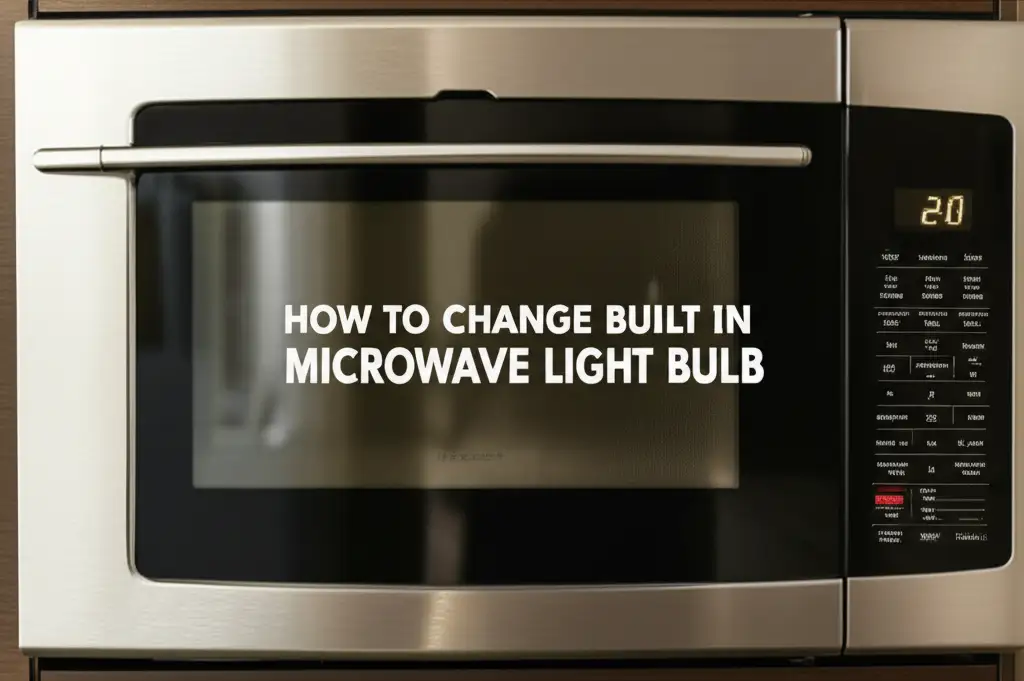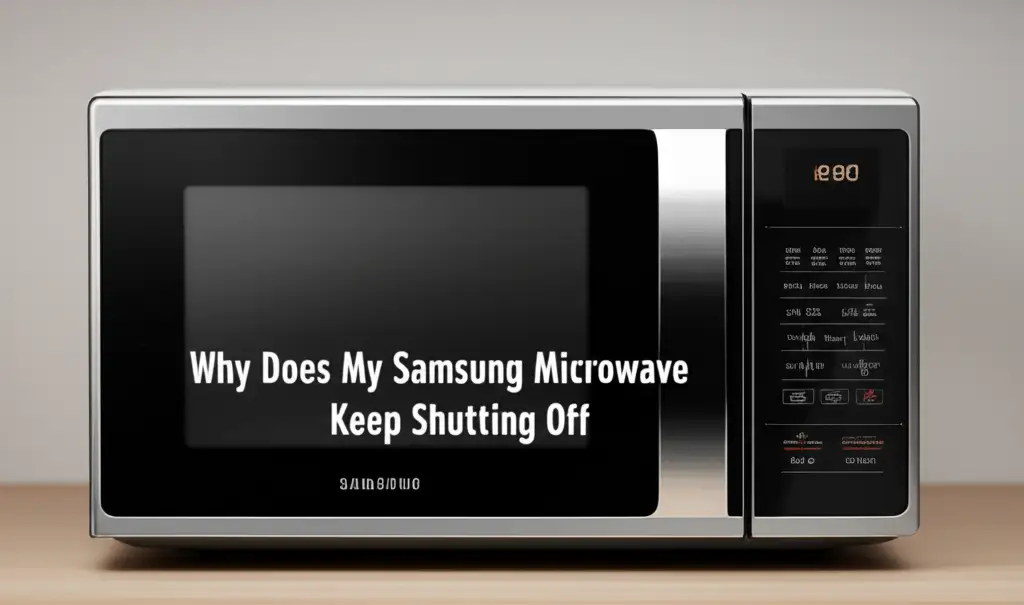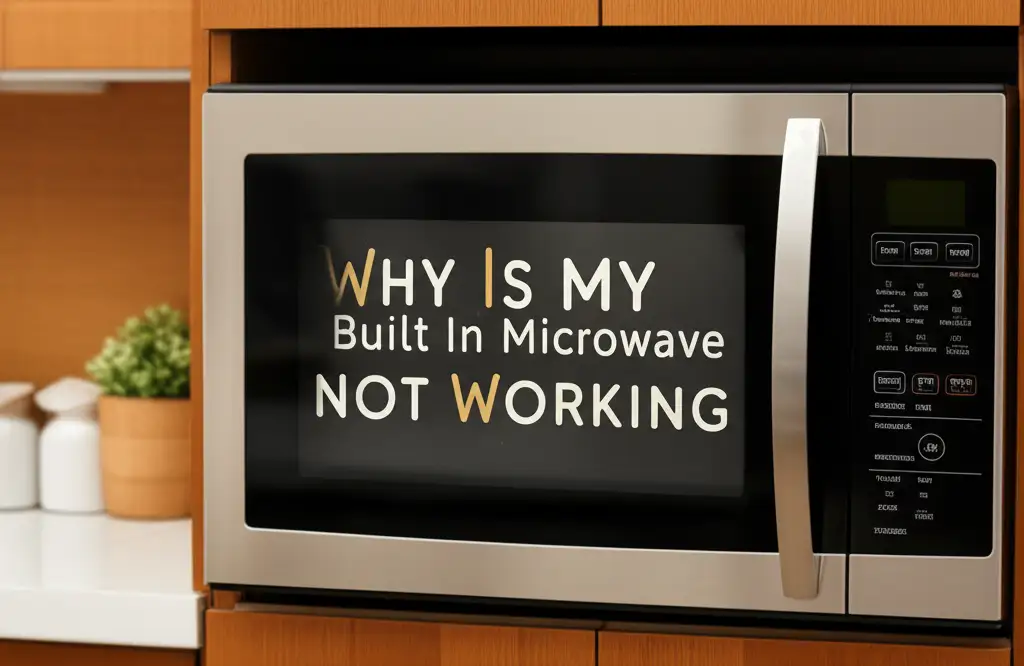· Davia Murnell · Home Appliances · 20 min read
How To Change Built In Microwave Light Bulb

How To Change Built-In Microwave Light Bulb
A dark microwave can be annoying. When your built-in microwave light bulb goes out, simple tasks like checking food become harder. You might wonder if this repair needs a professional. The good news is that changing a built-in microwave light bulb is a task many homeowners can do. It requires some care and the right steps.
This guide helps you understand the process. We will cover safety, tools needed, and clear instructions. You will learn how to replace the bulb in your built-in microwave. By the end, you will feel ready to light up your microwave again.
Takeaway
- Always disconnect power before starting any repair.
- Identify the correct light bulb type for your microwave model.
- Accessing the bulb usually involves removing a vent grille or control panel.
- Follow specific steps for your microwave’s design to avoid damage.
The Quick Answer
To change a built-in microwave light bulb, first, unplug the unit for safety. Next, find the bulb’s access point, often behind a vent grille, control panel, or by removing the microwave from its cabinet. Carefully remove the old bulb and install the new one. Then, reassemble the microwave and restore power.
Is Your Built-In Microwave Light Bulb Out? Recognizing the Signs
A working light inside your microwave helps you see your food. It makes cooking and cleaning easier. When this light stops working, your microwave use changes. You might find yourself peering into a dark box.
Many built-in microwaves have two kinds of lights. One illuminates the inside cavity. The other shines down on your cooktop below. This article focuses on the internal cavity light. Knowing which light is out helps you target your repair efforts.
Why Your Microwave Light Matters
The light bulb inside your microwave is important. It lets you check on food while it heats. You can see if your popcorn is ready. You can tell if your soup is bubbling. Without this light, it is harder to monitor cooking progress.
A working light also helps with cleaning. You can spot spills and splatters more easily. This helps keep your microwave fresh and clean. A dark microwave can hide messes. This makes cleaning less effective.
Common Symptoms of a Failed Bulb
The most common sign is no light at all. You press the door button, and nothing happens. The inside stays dark. Sometimes, a bulb might flicker before it dies completely. This flickering signals it is time for a change.
Other issues might look like a bulb problem but are not. If your microwave has no power at all, the issue is larger. This could be a tripped breaker or a power cord problem. If other parts of your microwave work, but only the light is off, a new bulb is likely the fix. Make sure the microwave itself still functions properly.
Safety First: Preparing for Your Built-In Microwave Light Bulb Replacement
Working with any electrical appliance needs care. Your built-in microwave is no different. Safety must be your top concern. Ignoring safety steps can lead to electric shock or damage to your appliance. A little preparation goes a long way.
Before you touch anything, think about power. The microwave connects to your home’s electricity. This power can harm you if not handled right. Take time to get ready. This ensures a smooth and safe repair.
Essential Safety Precautions
The first and most important step is to disconnect power. Do not just turn the microwave off. Unplug it from the wall outlet. If your built-in microwave is hard to unplug, find its circuit breaker in your home’s electrical panel. Flip the breaker to the “off” position. This stops all power flow to the unit.
You should wear protective gloves. This protects your hands from sharp edges. It also prevents oil from your skin from touching the new bulb. Skin oils can shorten a bulb’s life. Safety glasses are also a good idea. They protect your eyes from dust or falling parts. Do not rush any step. Take your time.
Gathering Your Tools and Supplies
You need a few basic tools for this job. A screwdriver set is essential. You will likely need both Phillips-head and flat-head screwdrivers. Small sizes are often best for appliance screws. A small pry tool or putty knife can help remove stubborn panels.
You will also need the right replacement bulb. Check your microwave’s user manual for the correct bulb type. If you do not have the manual, look for a model number. This is often on a sticker inside the microwave door. Search online for “[Your Microwave Model] light bulb.” Knowing the exact bulb type saves you a second trip to the store. You can often find this information on the appliance manufacturer’s website or by contacting their customer service.
Identifying the Light Bulb Location in Your Built-In Microwave
Built-in microwaves are designed to fit neatly into cabinetry. This design can make accessing parts seem tricky. However, the light bulb is usually in a common place. Its exact spot depends on your specific microwave model. Some designs let you access the bulb from inside the microwave cavity. Others require you to remove an exterior panel.
Understanding where to look saves time and effort. You want to avoid removing parts that do not need removal. Let us explore the most common places for the light bulb.
Internal Cavity Light Access
Most built-in microwaves have their internal light bulb inside the cooking cavity. It is often behind a small protective cover. This cover can be on the ceiling, side, or back wall of the microwave. The cover is usually made of plastic or glass. It might be held in place with screws. Sometimes, clips or tabs hold it.
Before you try to remove it, look closely. Are there visible screws? If so, use the right screwdriver to loosen them. If you see no screws, gently feel for clips. You might need to push or pull a tab to release the cover. Always be gentle to avoid breaking the cover. This access method is generally simpler, as it does not require moving the entire appliance.
External Access Points for Built-in Units
Some built-in microwaves require more effort. Their light bulb might be accessible from outside the appliance. This often means removing a top or side ventilation grille. It might even mean removing the entire microwave from its built-in cabinet. This is especially true for older models or those with unique designs.
To check for external access, examine the top, bottom, and sides of your microwave’s trim kit or frame. Look for screws that hold a grille in place. If you find one, remove it to see if the bulb is behind it. In other cases, the light bulb might be behind the control panel. This usually means carefully unscrewing the panel and gently pulling it forward. For some integrated units, the access might be from the top of the appliance, requiring it to be slid out from the cabinet. If you suspect the microwave needs to be pulled out, refer to guides on removing built-in appliances, such as how to remove built-in microwave with vent under cabinet. This gives a good idea of how these units are typically installed and removed.
Step-by-Step Guide: How to Access and Replace the Built-In Microwave Light Bulb
Replacing your built-in microwave light bulb involves a few key steps. Each step must be done carefully to prevent damage. Remember that specific models may vary slightly. However, these general instructions apply to most built-in microwaves. I will walk you through the process clearly.
Be patient with yourself throughout this task. Rushing can lead to mistakes. Taking your time ensures a successful bulb replacement.
Disconnecting Power and Preparing the Unit
Your first step is always to ensure safety. Locate the power outlet for your built-in microwave. Unplug it completely. If you cannot reach the plug, go to your home’s circuit breaker box. Find the breaker labeled for your kitchen or microwave. Flip it to the “off” position. Double-check that the microwave has no power before continuing.
Next, prepare your workspace. Lay down a towel or soft cloth on your countertop. This protects your surfaces and your microwave if you need to set parts down. Gather all your tools within reach: screwdrivers, pry tool, and the new light bulb. Having everything ready makes the job smoother.
Removing the Access Panel or Grille
This is where microwave models differ.
- For internal access: Look inside the microwave cavity for a small light cover. This cover might be clear plastic or glass. It usually has one or two screws holding it in place. Use your Phillips or flat-head screwdriver to remove these screws. Once screws are out, gently pry the cover off. Some covers have clips; you may need to gently twist or pull to release them.
- For external access (top/side grille): Many built-in microwaves have a top or side vent grille. This grille might be held by screws along its edges. Locate these screws and remove them. The grille should then lift or slide off. Be careful not to bend it. Sometimes, the light bulb is directly behind this grille.
- For behind the control panel or unit removal: In some cases, the bulb is behind the control panel. You might need to unscrew the control panel and gently pull it away. If your microwave is truly integrated and the bulb is not accessible from the cavity or a simple grille, you might need to slide the entire unit out. If this is the case, instructions like how to install your semi-built-in microwave column installation can give you insight into how these units are secured and removed. It’s often held by mounting screws inside the cabinet.
Replacing the Old Bulb
Once the access panel is removed, you will see the old light bulb. Most microwave bulbs screw in. Turn the old bulb counter-clockwise to unscrew it. It might be tight or hot if it just burned out, so be careful. Sometimes, bulbs are push-and-twist types. Gently push in and turn counter-clockwise, then pull it out. Make a note of how the old bulb connects before you remove it.
Once the old bulb is out, take your new bulb. Do not touch the glass part of the new bulb with your bare hands. The oils from your skin can cause hot spots and make the bulb burn out faster. Use a clean cloth or gloves to handle the new bulb. Screw the new bulb in clockwise until it is snug. Do not overtighten it. If it is a push-and-twist type, push it in and twist clockwise to secure it.
Reassembling Your Microwave
With the new bulb in place, you are ready to put everything back together. Reattach any access panels or grilles you removed. Make sure all screws are tightened. Do not overtighten them, as this can strip the screw holes. If you had to remove the control panel, carefully push it back into place and secure its screws.
If you had to slide the microwave out of its cabinet, carefully slide it back in. Ensure it sits properly in its designated space. Secure any mounting screws that hold it in place. Once everything is reassembled, plug the microwave back into the outlet. If you turned off a circuit breaker, go back to your electrical panel and flip it back on. Test the light to see your success. If you’ve previously worked with other microwave types, you might find some similarities or differences. For example, changing a bulb in an over-the-range microwave or a Whirlpool microwave hood combination often involves accessing external panels, which can be similar to some built-in units.
Choosing the Correct Replacement Bulb for Your Built-In Microwave
Selecting the right replacement bulb is important. Using the wrong bulb can cause problems. It might not fit, or it might burn out quickly. It could even damage your microwave’s electrical system. Before you buy a new bulb, know what to look for.
Microwave bulbs are not all the same. They come in different shapes, sizes, and power levels. Taking time to find the correct bulb will save you future trouble. I will tell you how to find the right one.
Understanding Bulb Specifications
Microwave light bulbs have specific features.
- Wattage: This is how much power the bulb uses. It is measured in watts (W). Your microwave has a maximum wattage rating for its light bulb. Using a bulb with higher wattage than recommended can overheat the circuit. This might lead to damage. Always match the wattage of the old bulb or use one with less wattage.
- Voltage: Most microwave bulbs are 120V. Some might be 125V or 250V depending on the microwave design. Using the wrong voltage can cause the bulb to burn out quickly or not light at all.
- Base Type: This refers to the part of the bulb that screws or plugs into the socket. Common base types include E17 (intermediate base), E12 (candelabra base), or a push-in wedge base. The base type must match your microwave’s socket exactly.
- Bulb Shape/Size: Microwaves have limited space. The physical size and shape of the bulb matter. An oversized bulb might not fit inside the protective cover.
Check your microwave’s user manual first. It will list the exact bulb specifications. If you do not have the manual, look for the model number on the microwave itself. It is usually inside the door frame or on the back. Search online using the model number and “light bulb type.” You can also take the old bulb to a hardware store. They can help you find a match.
Where to Find the Right Bulb
Once you know the specifications, finding the bulb is easy.
- Appliance Parts Stores: These stores specialize in replacement parts for home appliances. They often have a wide selection of microwave bulbs. The staff can also help you find the correct one.
- Online Retailers: Websites like Amazon, eBay, or specialized appliance parts sites carry many types of bulbs. Make sure to use your microwave’s model number or the bulb’s exact specifications when searching. Always read reviews to ensure you are buying a quality product.
- Manufacturer Websites: Many microwave manufacturers sell replacement parts directly. Check their official websites. This ensures you get an original equipment manufacturer (OEM) part. This might be more expensive but guarantees a perfect fit.
- Local Hardware Stores: Smaller hardware stores might have common microwave bulb types. It is worth checking, but their selection might be limited compared to appliance-specific stores.
Bringing the old bulb with you to the store is helpful. This allows for a direct comparison. For instance, if you changed a bulb in a GE countertop microwave, you might notice similar bulb types. However, always confirm the specifications as countertop models can differ from built-in units.
Troubleshooting Common Issues After Built-In Microwave Light Bulb Replacement
You have changed the light bulb, reassembled everything, and restored power. But what if the light still does not work? Or what if it flickers? Troubleshooting helps you fix these small problems. Do not get discouraged if the light does not come on right away. There are common reasons for this.
I will guide you through the next steps. These steps help you find out why your new bulb might not be working. Most issues are simple to correct.
Checking Connections
The first thing to check is the bulb’s connection.
- Is the bulb screwed in tightly? A loose bulb will not make electrical contact. Gently tighten the bulb a bit more. Do not overtighten, as this can damage the socket or the bulb.
- Did you put the access panel back correctly? Sometimes, a panel might block the bulb’s path. Ensure all parts fit snugly.
- Is the microwave plugged in? This might seem obvious, but it is easy to forget. Make sure the plug is fully inserted into the wall socket. If you used the circuit breaker, make sure it is fully in the “on” position.
Sometimes, the socket itself can be the problem. Inspect the socket for any damage. Look for bent metal tabs inside the socket. These tabs make contact with the bulb’s base. If they are bent, gently bend them back into place. Ensure they are not touching each other. This can cause a short circuit.
Ensuring Proper Bulb Type
Using the wrong bulb is a common reason for failure.
- Is the wattage correct? If the new bulb has too high a wattage, it might overload the circuit, causing the light to stay off or trip a fuse. If it is too low, it might not light up or be very dim.
- Is the voltage correct? A 120V bulb might not light in a 250V system.
- Is the base type correct? An E12 bulb will not fit an E17 socket. Even if it seems to fit, the connection might not be strong enough. Go back to your manual or model number to double-check the bulb specifications. If you used an old bulb for comparison, ensure it was the correct one to begin with. You might need to buy a different bulb if the one you installed is incorrect.
When to Call a Professional
Most light bulb issues are solvable with the above steps. However, some problems need expert help.
- Light still not working after checking all connections and bulb type: This might point to a deeper electrical issue within the microwave. It could be a faulty socket, wiring, or a control board problem.
- Smoke or burning smell: If you see smoke or smell something burning, immediately unplug the microwave or turn off the breaker. Do not use the microwave. This indicates a serious electrical fault.
- Microwave not working at all: If the microwave itself has no power, not just the light, the issue is more complex than a bulb. It could be a main fuse, transformer, or control board problem.
- Unusual noises or sparks: If you hear strange sounds or see sparks when you turn the microwave on, stop using it. These are signs of internal damage.
For these complex issues, it is best to call a qualified appliance repair technician. They have the tools and knowledge to diagnose and fix internal electrical problems safely. Attempting to fix these yourself can be dangerous.
Maintaining Your Built-In Microwave for Long-Term Performance
Changing a light bulb is one step in microwave care. Proper maintenance helps your built-in microwave last longer. It also ensures all its parts, including the light, work well. A well-maintained appliance performs better. It also needs fewer repairs over its life.
I will share some tips for overall microwave health. These simple habits can make a big difference. They help you enjoy your microwave for many years.
Regular Cleaning Habits
Keeping your microwave clean is crucial. Food spills and splatters can build up. This grime can cause smells. It can also affect how the microwave heats food. Worse, severe buildup can block vent holes. Blocked vents can make internal parts, including the light bulb, run hotter. This heat can shorten the bulb’s life.
- Wipe down daily: After each use, wipe the inside with a damp cloth. This removes fresh spills before they dry.
- Deep clean weekly/monthly: For tougher messes, place a bowl of water with lemon slices inside. Heat it for a few minutes until steam fills the cavity. Let it sit for 5-10 minutes. The steam loosens dried food. Then, wipe everything clean with a cloth.
- Clean the exterior: Wipe down the control panel and door. Use a soft cloth and a mild cleaner. Avoid harsh chemicals that can scratch surfaces.
Regular cleaning prevents grease and food particles from entering vent areas near the light bulb. This helps the bulb stay cool and perform better.
Tips for Extending Bulb Life
Even with proper cleaning, bulbs will eventually burn out. However, you can take steps to help them last longer.
- Avoid rough handling: When installing a new bulb, be gentle. Dropping or jostling the bulb can damage its filament.
- Use the correct bulb: As discussed, the right wattage and type are key. An incorrect bulb can fail quickly due to stress.
- Limit unnecessary use: If your microwave has an “oven light” setting, consider using it only when needed. Leaving the light on for long periods adds wear and tear.
- Check ventilation: Make sure your microwave’s ventilation system is clear. This includes the internal vents and any external exhaust fan if your built-in model has one. Proper airflow prevents overheating. Overheating can damage the light bulb and other internal components. For some built-in units that also vent, checking how to manage built-in microwave ventilation might offer insights.
- Handle with gloves: Always use gloves or a cloth when touching a new bulb. Oils from your skin can create hot spots on the glass. These hot spots make the bulb burn out faster.
By following these simple maintenance and care tips, you not only extend the life of your light bulb but also keep your entire built-in microwave running well.
FAQ Section
How long does a built-in microwave light bulb usually last?
The lifespan of a built-in microwave light bulb varies. It depends on how often you use your microwave. On average, a microwave light bulb can last from 500 to 2,000 hours of use. Factors like voltage stability and how well the microwave vents heat can also affect its life.
Can I use an LED bulb in my built-in microwave?
Sometimes you can use an LED bulb. However, it needs to be specifically designed for microwave use. Standard LED bulbs may not handle the heat or vibrations inside a microwave. Check your microwave’s manual or the manufacturer’s website for approved bulb types. Using an incompatible bulb can damage the microwave.
Why is my new microwave light bulb not working?
If your new bulb does not work, first, check if it is screwed in tightly. Ensure the microwave is fully plugged in or the circuit breaker is on. Verify that you installed the correct bulb type and wattage for your specific model. If the problem continues, the socket or wiring might have an issue.
Is it hard to change a built-in microwave light bulb?
Changing a built-in microwave light bulb is generally not hard. It requires careful steps and some basic tools. The biggest challenge is often accessing the bulb, which might involve removing trim pieces or sliding the microwave out of its cabinet. With clear instructions, most homeowners can do it.
What tools do I need to change the light bulb?
You will need basic hand tools. A Phillips-head screwdriver and a flat-head screwdriver are usually required. Sometimes, a small pry tool or putty knife helps. You will also need the correct replacement light bulb. Always have these items ready before you start the repair.
Should I call a professional if I cannot change the bulb myself?
Yes, if you feel unsure or cannot access the bulb safely, call a professional. Appliance repair technicians have the experience and tools to handle complex access or underlying electrical issues. Your safety and the microwave’s integrity are important.
Conclusion
A burnt-out light bulb in your built-in microwave can be a small but annoying problem. It makes daily tasks harder and takes away from your kitchen’s convenience. However, as we have explored, replacing a built-in microwave light bulb is a task you can often do yourself. With careful planning and attention to safety, you can restore light to your appliance.
You now understand the essential steps. You know how to disconnect power, identify the bulb, and install a new one. Remember to always use the correct bulb type for your model. By following these steps, you can save money and feel good about your DIY skills. If you face bigger issues, do not hesitate to call a professional. Get your microwave shining brightly again today!
- microwave repair
- built-in appliance
- light bulb replacement
- kitchen maintenance
- DIY appliance fix
- home repair guide





